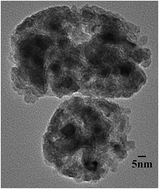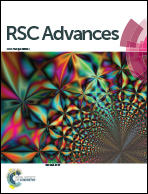The role of carbon in structural evolution during single step synthesis of nano tantalum carbide†
Abstract
Cubic phase carbon-coated nano tantalum carbide (TaC) has been synthesized at 800 °C in a single step from tantalum oxide using the carbon and hydrogen produced in situ via decomposition of acetone in an autoclave. In the product phase(s) carbon exists: (a) inside the carbide, (b) on the surface of the carbide particles and (c) as free carbon (amorphous as well as graphitic). The effects of initial carbon concentration on the final carbon content inside as well as outside the TaC have been studied. The structural features of the final product have a complex dependency on the initial carbon concentration. The thermal behaviour of the final product clearly delineates the effects of internal and external carbon content. The soaking time studies show that the grain growth of TaC within the autoclave follows the simultaneous grain boundary migration and grain rotation model. The DSC/TG, XRD and microstructure analysis results along with thermal calculations have been used to predict the formation mechanism for the carbide particles. The reaction mechanism analysis brings forth the role of Mg in lowering the reaction temperature. In this process the carbon content of TaC, the size as well as the strain of the synthesized powders and the %free carbon content can be tailored as per the requirement for the given application.


 Please wait while we load your content...
Please wait while we load your content...